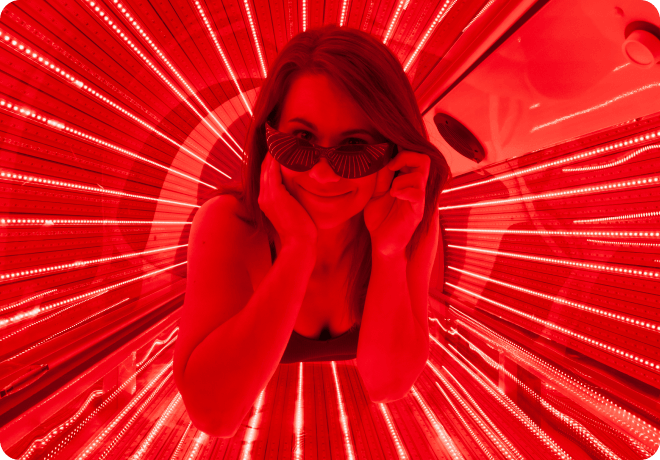How Light Therapy Works?
- By rgpodadmin
- October 24, 2023

Understanding Red Light Therapy (PBM)
Red light therapy, also known as light therapy, low-level laser therapy (LLLT) or photobiomodulation (PBM), has emerged as a revolutionary approach in the field of medical science and wellness treatments. Its journey from serendipitous discovery to a well-studied therapeutic intervention has been marked by a wealth of research unveiling its potential benefits for various health conditions. PBM offers a drug free option to help with a variety of conditions with minimal (if any) side effects.
How It Works
At its core, red light therapy operates on the principle of photobiomodulation, whereby specific wavelengths of light stimulate cellular processes and produce therapeutic effects. Red and near-infrared wavelengths, typically in the range of 600 to 1000 nanometers, penetrate the skin and are absorbed by chromophores within cells, notably the mitochondrial enzyme cytochrome c oxidase (CCO). This energy is utilized by CCO to trigger a cascade of biochemical reactions, leading to the increased production of adenosine triphosphate (ATP), the primary energy currency of cells. The enhanced ATP production fuels cellular metabolism, accelerates tissue repair, and facilitates various physiological responses essential for health and well-being.
Moreover, PBM influences signaling pathways and gene expression, modulating cellular processes such as inflammation, apoptosis, and oxidative stress. By promoting antioxidant defenses and mitigating oxidative damage, red light therapy exerts protective effects on cells and tissues, contributing to their resilience and longevity.
What Are The Potential Benefits?
While research continues to evolve, the following is a partial list of benefits that are being studied and verified:
Pain Management: PBM has been used to alleviate both acute and chronic pain, including musculoskeletal pain, neuropathic pain, and pain associated with conditions like Fibromyalgia & Plantar Fasciitis:
“Low power laser therapy seemed to be an effective method in reducing pain and functional disability in the therapy of chronic lower back pain (LBP)” (Gur, 2003).
Wound Healing: It can aid in wound healing by promoting tissue repair, reducing inflammation, and accelerating the closure of wounds, including diabetic ulcers, pressure ulcers, and surgical wounds.
“Low-level light therapy accelerates wound healing and reduces the size of diabetic foot ulcers.” (Zhao, 2021)
Inflammation Reduction: PBM has anti-inflammatory effects and may help in conditions characterized by inflammation, such as arthritis, tendonitis, and inflammatory skin conditions.
Muscle Recovery and Performance Enhancement: Athletes and individuals involved in physical activities use PBM to speed up recovery from exercise-induced muscle fatigue, reduce muscle soreness, and potentially enhance athletic performance
“The clinical impact of these findings is clear because they demonstrate that the use of phototherapy is more effective than the use of cryotherapy for muscle recovery, additionally cryotherapy decreases PBMT efficacy.“, (De Marchi, 2017).
Neurological Conditions: PBM has shown promise in the treatment of neurological conditions like stroke, traumatic brain injury (TBI), and degenerative diseases such as Alzheimer’s and Parkinson’s disease by promoting neuroregeneration and neuroprotection.
“There was significant improvement after 12 weeks of PBM (MMSE, p < 0.003; ADAS-cog, p < 0.023). Increased function, better sleep, fewer angry outbursts, less anxiety, and wandering were reported post-PBM. There were no negative side effects.“, (Saltmarche, 2017).
Dermatological Conditions: PBM has been explored as a treatment for various skin conditions, including acne, psoriasis, and alopecia (hair loss).
Oral Health: PBM has been investigated for its potential in promoting oral health, including the treatment of oral mucositis (a common side effect of chemotherapy and radiation therapy), periodontal disease, and temporomandibular joint (TMJ) disorders.
Ophthalmic Conditions: PBM has been studied for its effects on improving vision and treating conditions such as macular degeneration and diabetic retinopathy.
“In conclusion, this study shows that LLLT may be a novel long-lasting therapeutic option for both forms of AMD. This is highly effective treatment that improves visual acuity for a long time.” (Koev, 2012).
Mental Health: While still in its early stages, there’s some research suggesting that PBM may have benefits for mental health conditions like depression, anxiety, and cognitive decline.
References and Cited Works
- de Oliveira, Marcelo F. et al., Low-intensity LASER and LED (photobiomodulation therapy) for pain control of the most common musculoskeletal conditions, European Journal of Physical and Rehabilitation Medicine 2022 April.
https://www.ncbi.nlm.nih.gov/pmc/articles/PMC9980499/ - Gur, Ali et al., Efficacy of low power laser therapy and exercise on pain and functions in chronic low back pain Lasers in Surgery and Medicine, 2003
https://pubmed.ncbi.nlm.nih.gov/12605431/ - De Marchi, Thiago et al., Does photobiomodulation therapy is better than cryotherapy in muscle recovery after a high-intensity exercise? A randomized, double-blind, placebo-controlled clinical trial, Lasers Med Sci., 2017 Feb,
https://pubmed.ncbi.nlm.nih.gov/28054262/ - Koev, K et al., Two year follow-up of low-level laser therapy (LLLT) in patients with age-related macular degeneration (AMD)Volume 90, Issue s249
Special Issue:Abstracts from the 2012 European Association for Vision and Eye Research Conference, 2012 Sept.
https://onlinelibrary.wiley.com/doi/10.1111/j.1755-3768.2012.S053.x - Saltmarche, A et al., Significant Improvement in Cognition in Mild to Moderately Severe Dementia Cases Treated with Transcranial Plus Intranasal Photobiomodulation: Case Series ReportPhotomedicine Laser and Surgery, 2017 Feb,
https://pubmed.ncbi.nlm.nih.gov/28186867/



